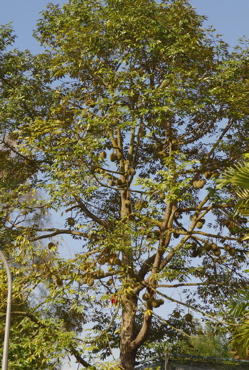Dr Ivan Polunin lives in Hillview, off Upper Bukit Timah Road. Fronting his house is an old and very tall durian tree (Durio zibethinus) (left). For the years he has been living in his current house, he claims that he has yet to taste the fruits.
Every fruiting season the tree gives forth many fruits. These invariable fall when ripe. All the fruits on the ground would have been damaged by the Common Red-bellied squirrel (Callosciurus.notatus), also known as Plantain Squirrel.
During the last flowering season there were numerous flowering buds that developed into flowers. The squirrels came regularly to feast on the fleshy petals. He filmed the flowers one night with the aid of infra-red lamps. The video was on for an hour but there was no sign of any bats visiting the flowers.
As there were no bats pollinating the flowers, Ivan concluded that the squirrels must have done the job. In the process of eating the petals, they must have invariably transferred pollen to the stigmas.
For the record, the literature reports pollination by bats and night-flying moths. Pollinating by squirrels may be something new.
The flowers eventually developed into fruits and when the ripening fruits were at the optimal ripeness (from the squirrels’ standpoint), the squirrels came and gnawed an opening on the spiky fruit wall of each and every fruit – to get at the succulent flesh (below left).
The squirrels had first priority of the flesh. Then the White-crested Laughingthrushes (Garrulax leucolophus) took over from the squirrels (above right).
So far, we have documented Orange Bellied Flowerpeckers (Dicaeum trigonostigma) and Plain-throated Sunbirds (Anthreptes malacensis) eating the durian flesh: see HERE. There is also a claim that the Javan Myna (Acridotheres javanicus) was seen at the fruit. The Perak Bird Group of the Malaysian Nature Society has documented on video a Black-naped Oriole (Oriolus chinensis) feasting on the fruit.
Dr Ivan Polunin
Singapore
November 2007
(Images of durian by YC and of squirrel-durian and laughingthrush by Johnny Wee)











3 Responses
That was interesting, thanks for that!
I think I have come across a reference to Dr Polunin in the published diaries (vol. 4, pp. 84-5) of Australian artist Donald Friend, of whom I am writing a biography. Date: March 1968; place: Bali. Could someone please confirm this is the same person?
Dr Ian Britain.
[email protected]